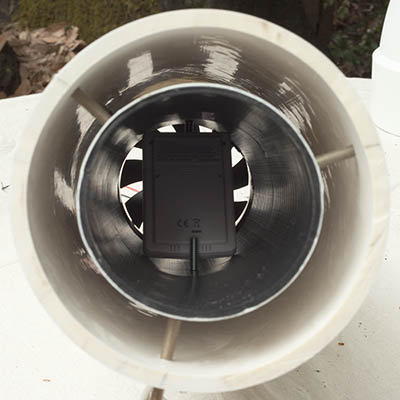
Partially assembled solar radiation shield
New: Updated design available (version 5), and report on radiation shield comparison test.

Partially assembled solar radiation shield
Solar radiation shields permit the measurement of air temperature in the presence of bright sun -- without allowing the sun to warm the thermometer, which would give a falsely high measurement of air temperature. Shields come in naturally ventilated (or "aspirated") versions, and fan-aspirated versions. The latter are often referred to by the acronym "FARS".
The professional standard for naturally aspirated shields is the Stevenson screen. This is a large wooden, louvered structure usually about two feet square (or larger) and 30-inches high. Much more common among amateur weather stations are a type of shield made from a series of stacked, inverted bowl-shaped plates with an open interior. These are often called Gill-type shields. A well designed shield like this works fairly well, but can still exhibit errors of one to two degrees Celsius or more on a hot, sunny day with calm winds.
Another excellent solution to the solar radiation problem is to use a powered fan to create a forced airflow. A well designed fan-aspirated shield will out-perform naturally aspirated shields. The download section below links to a document detailing the results of a test comparing the FARS project here to some naturally aspirated shields. The author of this project has not had the opportunity to compare these projects to a Stevenson screen, however.
This project comes in two versions. The large size shield has the advantage of an air intake angled 45-degrees downards instead of directly downwards (as is found in many fan-aspirated shields). This comes closer to taking the air sample at a fixed height above the ground as happens with a true Stevenson screen. The downside is that the shield is quite large and may not be aesthetically acceptable in some cases.
The smaller version has an air intake directed straight downwards. On the plus side, it is much smaller and will be aesthetically acceptable in a wider range of situations (it might even be mistaken for some kind of bird feeder).
While the smaller version should perform nearly as well as the larger version, a comparison made by the author of these projects shows a difference in measurements between the two shields of one degree Celsius or a bit more in some cases. The smaller shield is effectively sampling a vertical column of air while the larger shield has a 45-degree upwards intake; it is likely that at least some of this difference is due to this fact.
![]() Instructions for building the current (version 5) FARS, including a performance test report.
Instructions for building the current (version 5) FARS, including a performance test report.
PDF document
![]() Instructions for building the original version FARS (not recommended).
Instructions for building the original version FARS (not recommended).
PDF document
![]() Instructions for building a smaller FARS.
Instructions for building a smaller FARS.
PDF document
![]() A comparison of FARS performance to natuarally aspirated shields.
A comparison of FARS performance to natuarally aspirated shields.
PDF document

